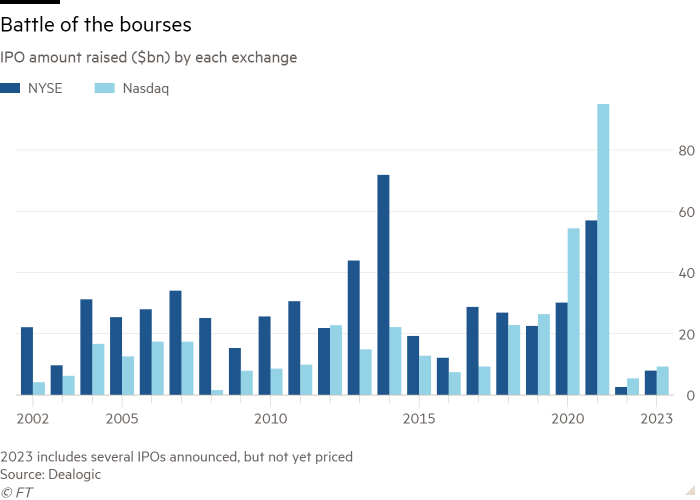Nasdaq and NYSE fight closest listings contest in five years

Simply sign up to the US equities myFT Digest -- delivered directly to your inbox.
Instacart’s flotation this week will inch Nasdaq further ahead of the New York Stock Exchange in their closest fight for new listings in five years — less than a week after the bourse’s $5bn initial public offering of chip designer Arm put it back in the game at all.
Including Instacart’s sale of up to $660mn in stock as well as other deals under way, Nasdaq has helped companies raise $9.3bn this year compared with $8bn for NYSE, according to Dealogic data and Financial Times calculations.
NYSE, located in a landmark building in New York’s downtown financial district, has won the annual battle in all but five of the past 20 years. But Nasdaq, headquartered on Times Square, has triumphed in the past four as tech-related IPOs dominate new listings.
The IPO market has stirred back to life in recent months after soaring interest rates and sinking valuations put an end to a previous boom in 2020 and 2021.
This month’s offerings include more tech stocks than earlier in the year, when the market was dominated by the $4.3bn spin-off of Kenvue, the consumer brands arm of Johnson & Johnson, which chose NYSE.
The two bourses compete fiercely for new listings, which generate annual fees as well as prestige. In February Nasdaq chief executive Adena Friedman flew to Japan to lobby Masayoshi Son, founder of Arm owner SoftBank, for the listing in a trip that was first reported by the Wall Street Journal.
Although the end of the tech boom has left Nasdaq and NYSE ranked behind Chinese counterparts in global IPO rankings, the New York exchanges have continued to lead in terms of total equity capital raising with $133bn this year — underscoring the importance to each of winning new listings to maintain that flow.
“As the IPO market begins to open, we look forward to welcoming a robust pipeline of companies,” said Michael Harris, NYSE’s global head of capital markets. “While most of the companies that have gone public this year do not meet NYSE listing standards, those that do can look forward to joining an unparalleled community of peer companies.”
Arm’s IPO on Nasdaq was the largest in almost two years. The company’s shares rose 25 per cent in its first day of trading.
“We’re proud to remain the exchange of choice for the most innovative companies in the world, with a win rate of over 88 per cent for the past two years,” said Karen Snow, global head of listings at Nasdaq, referring to the share of the number of companies that have listed.
Nasdaq’s lower listing fees and costs mean many smaller companies choose to float there, including capital-hungry biotechnology groups which frequently tap the market for funds — generating fees for their host exchange each time.
“It’s like choosing between a Bentley and a Tesla,” said Mark Mandel, chair of Baker McKenzie’s North America capital markets group. “You won’t go wrong with either, but companies, like people, tend to gravitate towards certain brands.”
This year’s competition for listings remains close.

In addition to Instacart’s Nasdaq debut, digital marketing group Klaviyo is due to price its NYSE IPO this week, raising about $500mn, while German shoemaker Birkenstock is expected to float up to $1bn of shares on NYSE in the coming weeks.
“The IPO is the culmination of a lot of hard work and effort, and companies want to celebrate and amplify their moment in the spotlight,” said Matthew Kennedy, senior strategist at Renaissance Capital, a provider of pre-IPO research and IPO-focused exchange traded funds.
Executives who choose NYSE get the chance to ring its famous opening bell in front of live traders. Nasdaq meanwhile offers an electronic billboard amid similarly sparkly adverts for Broadway shows and consumer brands around Times Square.
“Companies that pick the NYSE probably associate it with staying power and prestige — the building itself is a national historic landmark,” Kennedy said. “While NYSE has long since embraced electronic trading and removed any potential restrictions on tech issuers, Nasdaq’s reputation for being the exchange of cutting-edge tech has endured.”
Nasdaq charges a one-time listing fee of $270,000, compared with NYSE’s $295,000. Annual charges depend on factors such as the number of shares in circulation and whether a company has sold additional shares to raise new funds. The exchanges also offer some ancillary services in support of their listings, some of which can form part of negotiations for listing, said people involved.
Companies going public typically meet both exchanges before making their choice.
“Investors and issuers associate certain industries with one or the other exchange,” said Jeff Cohen, a capital markets partner in Linklaters’ New York office. “That is often the deciding factor because the issuers believe that will affect valuation.”
Nasdaq made $729mn in revenue, or just over a tenth of its total, from its data and listing services unit last year.
NYSE, part of Intercontinental Exchange since 2013, made $515mn from listings, equal to just less than a tenth of revenue from ICE’s broader exchanges business which also includes energy, agricultural and financial futures and options.
The contest between the two exchanges does not end after their new arrivals ring the opening bell.
Snow highlighted Nasdaq’s “incredible switch momentum”, with three already-listed companies transferring to Nasdaq from NYSE in the past week. Those included delivery app DoorDash, whose 2020 $3.4bn IPO was NYSE’s second-largest that year. DoorDash did not give a reason beyond looking forward to joining a community of tech companies.
While Nasdaq counts 11 companies moving to Times Square this year and 14 last year, NYSE reports 14 companies making the opposite trip so far in 2023 and 34 did so in 2022 — its highest number in two decades.
Comments